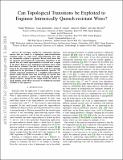Files in this item
Can topological transitions be exploited to engineer intrinsically quench-resistant wires?
Item metadata
| dc.contributor.author | Whittlesea, Philip | |
| dc.contributor.author | Quintanilla, Jorge | |
| dc.contributor.author | Annett, James F. | |
| dc.contributor.author | Hillier, Adrian D. | |
| dc.contributor.author | Hooley, Chris | |
| dc.date.accessioned | 2018-03-14T10:30:07Z | |
| dc.date.available | 2018-03-14T10:30:07Z | |
| dc.date.issued | 2018-06-01 | |
| dc.identifier | 252544325 | |
| dc.identifier | 062f6699-f721-49d3-b0a3-832fc20c9a97 | |
| dc.identifier | 85041208119 | |
| dc.identifier | 000425739200001 | |
| dc.identifier.citation | Whittlesea , P , Quintanilla , J , Annett , J F , Hillier , A D & Hooley , C 2018 , ' Can topological transitions be exploited to engineer intrinsically quench-resistant wires? ' , IEEE Transactions on Applied Superconductivity , vol. 28 , no. 4 , 8252800 . https://doi.org/10.1109/TASC.2018.2791515 | en |
| dc.identifier.issn | 1051-8223 | |
| dc.identifier.other | ORCID: /0000-0002-9976-2405/work/42734885 | |
| dc.identifier.uri | https://hdl.handle.net/10023/12937 | |
| dc.description | This work was supported by EPSRC through the project “Unconventional superconductors: New paradigms for new materials” under Grant EP/P00749X/1 and Grant EP/P007392/1. The work of P. Whittlesea was supported by a University of Kent 50th Anniversary Scholarship. The work of J. Quintanilla was supported by a SEPnet Fellowship held during the early stages of this work. | en |
| dc.description.abstract | In this paper, we investigate whether by synthesizing superconductors that are tuned to a topological, node-reconstruction transition point, we could create superconducting wires that are intrinsically resilient to quenches. Recent work shows that the exponent characterizing the temperature dependence of the specific heat of a nodal superconductor is lowered over a region of the phase diagram near topological transitions where nodal lines form or reconnect. Our idea is that the resulting enhancement of the low-temperature specific heat could have a potential application in the prevention of superconductor quenches. We perform numerical simulations of a simplified superconductor quench model. Results show that decreasing the specific heat exponent can prevent a quench from occurring and improve quench resilience, though in our simple model the effects are small. Further work will be necessary to establish the practical feasibility of this approach. | |
| dc.format.extent | 5 | |
| dc.format.extent | 248161 | |
| dc.language.iso | eng | |
| dc.relation.ispartof | IEEE Transactions on Applied Superconductivity | en |
| dc.subject | Energy dissipation | en |
| dc.subject | Superconducting filaments and wires | en |
| dc.subject | Superconducting magnetic energy storage | en |
| dc.subject | Superconducting magnets | en |
| dc.subject | Waste heat | en |
| dc.subject | QC Physics | en |
| dc.subject | TK Electrical engineering. Electronics Nuclear engineering | en |
| dc.subject | Electronic, Optical and Magnetic Materials | en |
| dc.subject | Condensed Matter Physics | en |
| dc.subject | Electrical and Electronic Engineering | en |
| dc.subject | NDAS | en |
| dc.subject.lcc | QC | en |
| dc.subject.lcc | TK | en |
| dc.title | Can topological transitions be exploited to engineer intrinsically quench-resistant wires? | en |
| dc.type | Journal article | en |
| dc.contributor.sponsor | EPSRC | en |
| dc.contributor.institution | University of St Andrews. School of Physics and Astronomy | en |
| dc.contributor.institution | University of St Andrews. Condensed Matter Physics | en |
| dc.identifier.doi | 10.1109/TASC.2018.2791515 | |
| dc.description.status | Peer reviewed | en |
| dc.identifier.url | https://arxiv.org/abs/1712.02771 | en |
| dc.identifier.grantnumber | EP/I031014/1 | en |
This item appears in the following Collection(s)
Items in the St Andrews Research Repository are protected by copyright, with all rights reserved, unless otherwise indicated.

